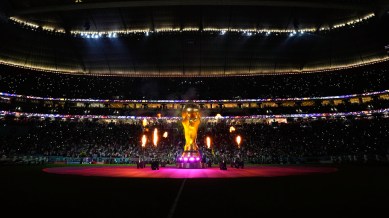Do the overpriced tickets for FIFA World Cup 2026 suggest it’s a tournament only for the rich?
At the top end, the 2026 FIFA World Cup final tickets at the MetLife Stadium in East Rutherford, New Jersey, are costing an estimated $6730 – and $25,000 on the resale market. While the cheapest group stage ticket at the World Cup is touted at $60, an extremely low number of those tickets are released, and most are in poor viewing positions at the stadium.

The last time the United States of America hosted a FIFA World Cup, ticket prices for a group stage game started at $25, the best seats for the final went up to $425, and the average cost of a ticket was $58, and Diego Maradona was playing for Argentina.
That World Cup, in 1994, gave FIFA the blueprint for the modern game’s economics – one where big ticket sponsors would be attracted, media rights would go for astronomical sums and a sizable profit ($1.45 billion estimated) would be pocketed by the organisation. Now, as the world’s biggest sporting event returns to North America after more than thirty years, the early sale price of tickets show a FIFA that will push for maximum revenues from an American World Cup.
monthly limit of free stories.
with an Express account.
What are the 2026 FIFA World Cup ticket prices like?
In one word, expensive. While it was expected that the ticket rates would be high, the issue, this time around, is the severe jump in prices that are being seen, along with dynamic pricing systems that ensure stadiums will reach full capacity, but access only remains in the hands of the people willing to shell out top dollar.
At the top end, the 2026 World Cup final tickets at the MetLife Stadium in East Rutherford, New Jersey, are costing an estimated $6730 – and $25,000 on the resale market. While the cheapest group stage ticket at the World Cup is touted at $60, as was seen in Qatar, an extremely low number of those tickets are released, and most are in poor viewing positions at the stadium. At the 2022 Qatar World Cup, the best ticket for the final between Argentina and France went for $1607.
Tickets have been divided into four categories with prices of scalps ascending from Cat 4 to Cat 1. The cheapest quarter-final ticket would be a Cat 4 in Boston for $275. The most expensive quarter-final ticket would be $1690 at the Sofi Stadium in Los Angeles. Similarly, the cheapest semi-final ticket would be $450 at Atlanta, and the most expensive semi-final ticket would be $2780 in Dallas. Another FIFA first is that all of these prices are subject to market fluctuations.
FIFA’s dynamic pricing punt
North American sports and entertainment industries run on dynamic pricing, a system where ticket prices are based on demand. FIFA will be employing this system for a World Cup for the first time. It had earlier tried dynamic pricing at the Club World Cup in the USA, where the final between Chelsea and Fluminese was priced at just under $474, but due to low demand, the ticket went down as low as $13 right before the final was about to start.
Dynamic pricing works great when matches have low interest, but in a big-ticket match, it pushes out local residents, unfairly targets poor countries and their fans, and caters to the highest dollar.
“I think the message is ‘Get your tickets early,’ especially if you know where you will be because you live in that city or you’re a fan of the three hosting nations, and then you know already when and where they will play,” said Heimo Schirgi, FIFA’s World Cup 2026 chief operating officer, in an interview to ESPN.
FIFA’s ticket reselling goldmine
Apart from dynamic pricing, FIFA has also introduced its own reselling platform. Ticket reselling is a practice where demand for tickets far outweighs seats at an event, and a second, private sale of the ticket happens at higher prices. Ticket reselling is a problem for the average fan who is priced out of an experience, and a problem for the event, which loses out on making more money. FIFA has figured out a fix for themselves by introducing their own platform for reselling tickets.
If tickets are resold on their platform, the world body takes a cool 15% of the final price of the ticket sold from the buyer as well as the seller. For example, if a ticket was sold for Rs 100, the seller would net Rs 85, and FIFA would net Rs 15. But if the original ticket buyer sold his ticket for Rs 115, then FIFA would pick up another 15% of that price as well.
Why are these practices anti-fans?
World Cup football is not just about what happens on the pitch but also what takes place in the stands. The 2014 World Cup in Brazil saw South American fans bring the noise across borders. The 2010 World Cup saw Vuvuzelas dominate the African landscape. These fans have a hand in making World Cups memorable. Pricing entire continents out of a World Cup is a critical mistake.
“This is not ‘make football truly global,’ this is the privatization of what was once a tournament open to all,” said Ronan Evain, executive director of Football Supporters Europe, in an interview with The Athletic. “FIFA’s leadership seems unable to understand that it needs fans in the stands. It needs life, the atmosphere, the colors, the diversity. None of this exists when you set such prices.”